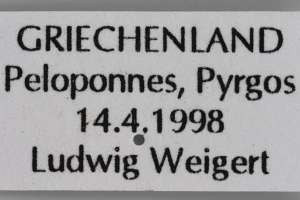

 +9Kontinente:EUAS
+9Kontinente:EUAS2. Diagnose
2.1. Weibchen
2.2. Geschlecht nicht bestimmt
2.3. Erstbeschreibung
3. Weitere Informationen
3.1. Taxonomie
Die Art wurde aus der Türkei beschrieben und lange Zeit meist als Synonym oder Unterart zu Merulempista cingillella gestellt. Plant (2016) widerspricht diesem Vorgehen und vermerkt: "Staudinger described Merulempista brucella as a new species in 1879, but Ragonot (1893) subsequently relegated it to synonymy as subspecies harterti of M. cingilella Zeller, 1846. Here it remained, in semi-oblivion, until Asselbergs (1997) reinstated it to specific rank. This move is, in my opinion, entirely correct not least because of the significant differences in the anellus of the male genital capsule and the shape of the cornuti in the aedeagus.
Plant (2016) kritisiert: "Leraut (2014) lists only M. ragonoti Rothschild, 1913, M. turturella (Zeller, 1848) and M. jucundella (Joannis, 1911) in addition to cingilella; the latter is presumably a typographical mistake for M. jucundella (Chrétien, 1911)? Leraut regards jucundella as the correct name for M. wolfschrijni Asselbergs, 1997, though he fails to illustrate the genitalia so that the reader is unable to form any opinion. His turturella is perhaps the same taxon as numidella Ragonot, 1893? further, his M. ragonoti cannot be that species as the type specimen in BM(NH) is quite different (Martin Honey, pers. comm.). There is clearly need for a revision of this genus." Merulempista-Arten alleine nach Leraut (2014) zu bestimmen, scheint demnach nicht ratsam zu sein!
3.2. Faunistik
Plant (2016) meldet die Art erstmals für Bulgarien; dazu stellt er fest: "The three Merulempista specimens known from Bulgaria are all preserved in NMNHS and all are referable to brucella: Struma Valley at Kresna, 1 ♂ 4.V.1929 (genitalia slide NMNHS/CWP 187), leg. Tuleshkov & 1 ♂ 1.VI.1929 (genitalia slide NMNHS/CWP 199), leg. Tuleshkov; east Rhodopes Mountains at Meden Buk, 1 ♂, 3.V.1013 [recte: 2013], leg. Beshkov. All specimens were named from genitalia dissection performed during 2015 by myself. Elsewhere, M. brucella is known from Turkey and as cingilella harterti from Italy (Asselbergs, 1997), whilst examples are also known from Dalmatia and Albania (Frantitisek Slamka, pers. comm., 2015). It is considered likely that dissection of museum specimens currently placed under the label of “cingilella” might reveal a wider distribution pattern for M. brucella, although no such specimens exist for Bulgaria." Die Art wurde also in der Türkei, Bulgarien, Dalmatien, Albanien und Italien nachgewiesen - "M. cingilella" aus diesem Raum sollten also nochmals gründlich auf ihre Artzugehörigkeit überprüft werden. Angebracht erscheint diese Vorsicht aber auch andernorts. Unser oben gezeigtes Diagnosebild stammt aus Griechenland.
Timossi (2020: 14) hatte die Art aus Venetien als neu für Italien gemeldet.
(Autor: Erwin Rennwald)
3.3. Literatur
- Asselbergs, J. (1997): Merulempista wolschrijni spec. nov. from The Netherlands and Merulempista brucella (Staudinger) stat. nov. from Turkey (Lepidoptera: Pyralidae, Phycitinae). — Entomologische Berichten 57 (1): 8-13. [Digitalisat auf biodiversitylibrary.org]
- Plant, C. W. (2016): An Annotated Systematic, Synonymic and Distributional Checklist of the Pyraloidea of Bulgaria (Lepidoptera, Crambidae & Pyralidae). — Neue Entomologische Nachrichten 72: 1-231.
- Slamka, F. (2019): Pyraloidea (Lepidoptera) of Europe. Volume 4. Phycitinae - Part 1. Identification - Distribution - Habitat - Biology. - 432 S., 175 Taf. mit Genitalabb., 31 Farbtaf. mit mehr als 900 Bildern zu 207 Arten; Bratislava (Eigenverlag František Slamka).
- Erstbeschreibung: Staudinger, O. (1879-1880 [159-368: 1879; 369-435: 1880]): Lepidopteren-Fauna Kleinasien's. — Horae societatis entomologicae rossicae 15: 159-435. St. Pétersbourg (V. Besobrasoff & Comp.).
- Timossi, G. (2020): Contributo alla conoscenza dei lepidotteri della Riserva Naturale Regionale Integrale “Bosco Nordio”. - Lavori – Soc. Veneziana Sc. Nat., 45: 5-29. [zum PDF-Download auf researchgate.net]















